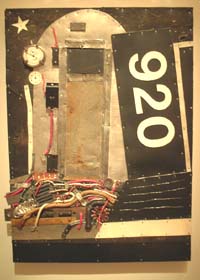Railway Lands

Artist Eric Walker 's "a steel drivin' man". Like John Henry in
the American railway folk song, Walker works with a hammer in his hand.
John Henry pounded his way to death and legendary history in the creation
of the trans-US rail link. Eric Walker hammers out his own history in
connection to the Canadian Railways.
Born in Halifax, Nova Scotia, Walker uses trains as a recurring theme
in his art. He creates collages depicticing trains, by nailing bits and
pieces of steel onto wooden boards. The trains are presentedside on like
Egyptian gods.
Walker is a stickler for detail. His constructions are made from odds
and ends carefully shaped to recreate many of the actual workings of trains
such as springs, engine numbers and names. His works, however, are abstracts
of the vehicles they represent. He adds all sorts of old junk wires, computer
motherboards, cans and coins to portray the impression of a train's inner
workings. Bits of cut tin are polished to metallic silver before being
nailed into position with flat-headed nails.
The trains are set against a night sky - silently whirring their way across
a sleeping landscape. Walker's skies sometimes contain a coin or railway
token nailed down as a star. His art is made from hundreds of individual
parts secured by a legion of nails.
Eric Walker's work has a folksy naivete about it. However, by the postmodern
rhetoric in the artist notes, I am sure he would be affronted by such
an assertion. Nonetheless, in the category of "na∑ve art" he is not in
bad company. I am reminded of American artist Joseph Cornwell's obsessive
boxes of faraway p;aces and the exotic paintings by Henri Rousseau, the
naive postman painter befriended by the French avant garde at the turn
of the last century.
Walker's prosaic subject matter - trains, the tick for tack construction,
hammering in so many nails, his obsession for detail – including recording
places and times in his titles, makes him close to these kind of artists.
It is also what is captivating about his work.
The large piece, 'Montreal Commuter train/train de Banlieu 2001', was
made specifically for this exhibition space and stretches impressively
across the front wall. It consists of an engine and 6 carriage sections
and is over 4 meters in length. Another of his works, made two years ago
but not in this exhibition, is an epic 20 meters in length. These John
Henry type feats of hammering and their long length seems to embody the
vastness of the Canadian landscape over which these trains journey.
Trains have a romantic quality about them. Locked onto their tracks, many
trains draw their fame, and take on the persona, from the countryside
over which they glide. Trains offer sights, sounds, style and travel in
a shared experience. It is not surprising then that trains have featured
in so much classic music, literature, film and art. Eric Walker journeys
the "Railways lands" with many great artists.



